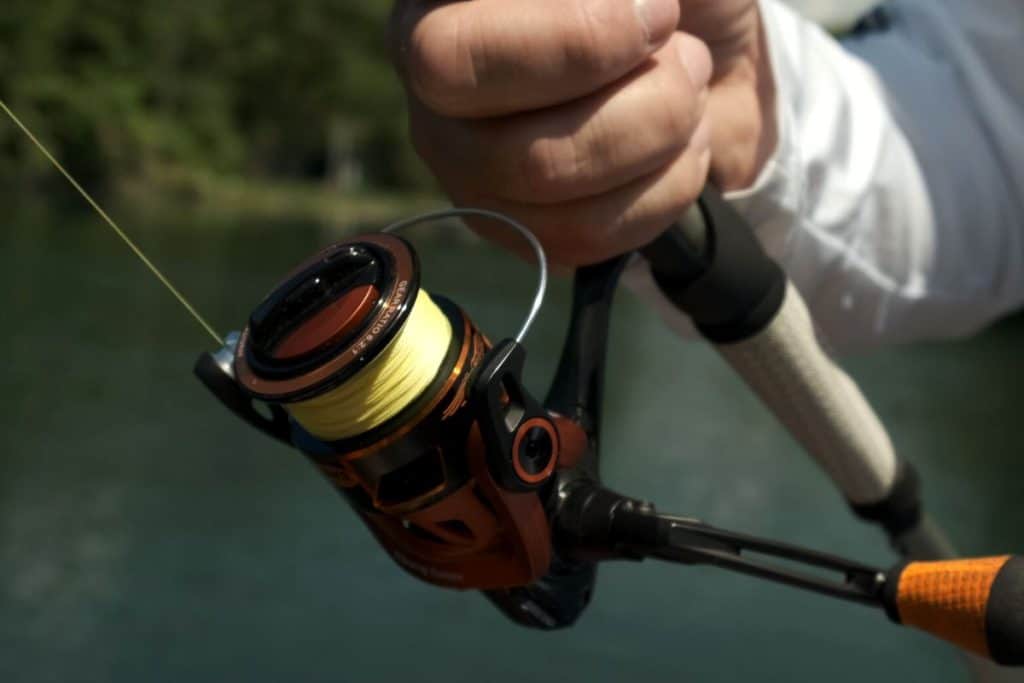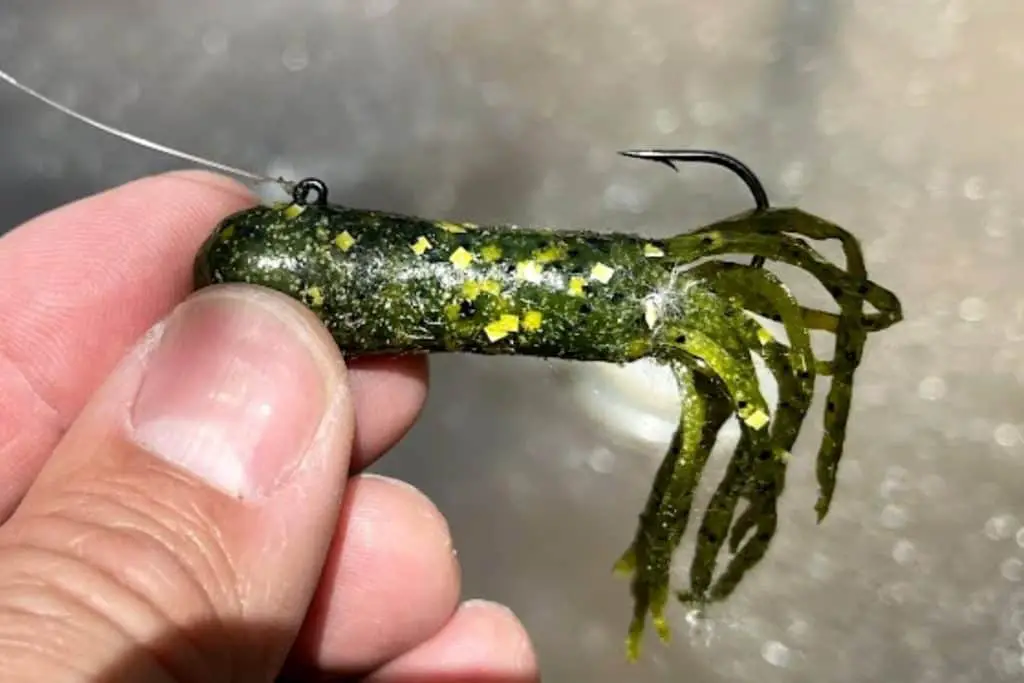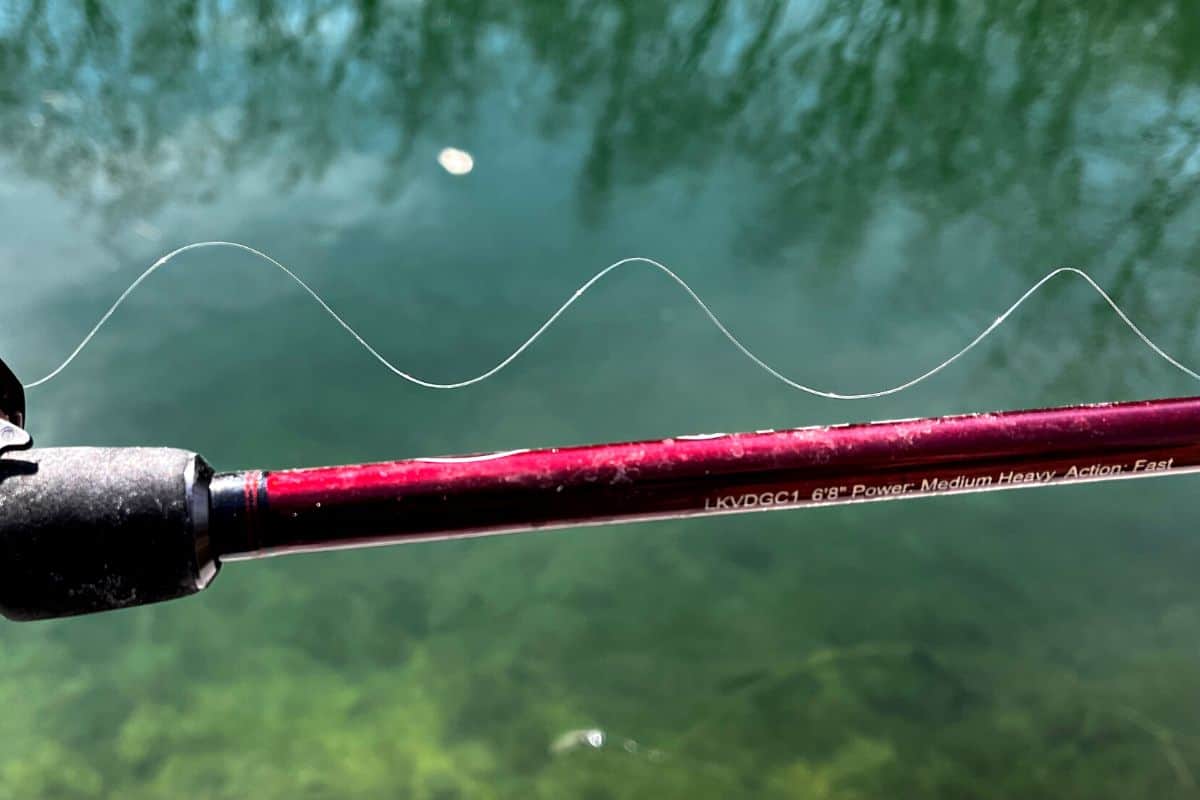Line twist is a total nightmare for anglers. It reduces casting distance, creates huge snarls, and leads to re-spooling which costs more money.
Eliminate line twist by spooling baitcast and spinning reels correctly, using a braid mainline, rigging lures straight, and adding a swivel on techniques that are notorious for causing a lure to rotate at the end of a retrieve.
This guide will go over the root cause of line twist and how to eliminate it.
What Causes Line Twist?
Understanding the root of the problem will help anglers stay a step ahead of this dreaded issue.
First, monofilament and fluorocarbon lines are prone to twist over time. If the line is spooled on incorrectly, the problem will be even worse and start after a few casts.
Another key culprit is how our lure is behaving when retrieved – most noticeably how it is riding in the water column at the end of the retrieve when we are reeling up line quickly to make another cast.
Anglers that see the lure rotating, or circling, on the quick retrieval will have huge issues with line twist. This can happen even after fresh line is put on.
How to Properly Spool Line with Baitcast and Spinning Reels
This first step is the most important. Let’s start with baitcast gear.
The spool of line should be held in the same direction as the spool of the reel. See the below image.
The line should feed from the back, over the top of the spool, and then to the baitcast reel. Transferring the line from one spool to the other in this manner will result in a smooth and twist-free reel ready to use.
Spooling a spinning reel can be a little more challenging.

The orientation of the spool on a spinning reel is what creates the potential problem.
The first step is to check the rotation of the spinning reel when you rotate it. Does the rotor turn clockwise when viewing it from the rod tip end? If it does, then you want the line coming off the spool counterclockwise.
The spool should be set flat on a tabletop. (See the image below.)
If the line is coming off the spool and going on the spinning reel correctly, there will be no line twist during the process. If you notice your line twisting while loading the reel, flip the spool of line over. It is very easy to tell if the line is coming off the wrong direction because you will have a mess really fast.
A Braided Mainline is a Game-Changer
The easiest and most efficient way that I know to stop line twist is to use a braid mainline with a fluorocarbon or monofilament leader.
While this is not perfect for every presentation and technique, it will work well for the vast majority of them. Braid virtually has no line memory at all. Once in a great while, there will be a slight twist but it pulls out nicely and most often does not happen again.
For example, on all my spinning reels I use a 20lb hi-vis yellow braid. I then use a Red Phillips knot to connect my leader material. The extra casting distance is incredible. Even ultra-lightweight lures, like a Ned rig, cast a mile. Not to mention the increased sensitivity of braid makes it worth using whenever possible.

I start with a piece of leader approximately the same length as the rod. This allows me to cut off and retie a lure several times before attaching a new piece of leader material.
Fishing with a braid mainline is such a game changer I cannot believe it took me so long to make the switch.
The only presentations that I stick with a full reel of fluorocarbon line are when using crankbaits, hard-suspending jerkbaits, and sometimes spinnerbaits. For my topwaters, I will either use braid, braid to a leader, or straight monofilament.
I even use braid with my drop shot rig. I run braid to a swivel and then attach my fluorocarbon at that point. The hook rests a couple of feet below the swivel. A drop shot is one of the most notorious rigs for creating line twist when reeling up the lure at the end of the presentation. The use of a swivel and braid makes this a non-issue.
(Here is an article on the fishing line the pro anglers use.)
Rigging Our Lures Straight Will Help Eliminate Line Twist
This is a common problem, especially for newer bass anglers that may have not mastered the art of rigging soft plastics.
Keeping the hook in the center of soft plastics will help them pull back to the angler with little or no line twist. Certain lures, like a tube with an insert tube head, can roll horribly on the retrieve. The jig head must be placed straight in the cavity of the lure. This will ensure the line tie and hook point are in-line with each other.
Many manufacturers now mold a cavity into their lures which helps with straight rigging, but sighting down the length of the lure before making that first cast is worth the effort. Adjust the hook if needed and you will be glad you did.

Adding a Swivel Can Prevent Line Twist
As mentioned above, a drop shot rig and a soft plastic tube with an insert tube head are two of the worst offenders. By far.
Adding a small swivel can stop any line twist you may be experiencing.
My first choice is to not need a swivel, but sometimes it is the best option and I cannot say I have ever noticed it impacting the bite in a negative way.
Methods to Fix Line Twist on a Reel That is Having Problems
Sometimes our line coming off the reel is just a disaster and re-spooling may not be an option at the moment. These are two methods I have used that work well.
First, if you are in a boat and are struggling with line twist, try the following.
Cut off the lure, and then while idling with the big motor, release the spool and let the line trail out behind the boat. You may need to pull some line to get started, but once you have a few yards of line out the friction from the water will keep pulling the line for you.
Once you have a good amount of line pulling behind you, keep idling. The resistance from the water will roll the line in the opposite direction of the twist. This is the exact same method contractors use when pulling a long extension cord through the grass to get the twist out. It works really well.
When the line lays flat in the water, reel it in, tie your lure back on, and fish away.
The next method will work if you are not in a boat.
Cut your lure off and tie the loose end to something solid. Then hold your fishing rod parallel to the ground and start to walk away from the point of connection.
Once you have thirty or forty yards of line out, engage the spool and hold the line firmly with your hand while grasping the rod up the blank.
Start to pull back so you are stretching the line. The amount of stretch in monofilament will shock you. Keep working the line by pulling the twist out of it. Walk towards the area you tied the line off and let the line go limp.
If it is straight with no twist, you are done. If the line is still showing twist, stretch it again.
Good luck out there and be sure to encourage someone today. You never know how you might just change their life forever.
Isaiah 6:8

